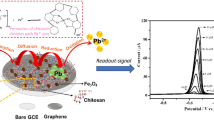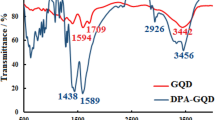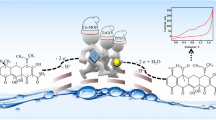Abstract
Based on the modulated electronic properties of Fe3O4-graphene (Fe3O4/GN composite) as well as the outstanding complexation between Pb2+ and natural substances garlic extract (GE), a novel electrochemical sensor for the determination of Pb2+ in wastewater was prepared by immobilization of Fe3O4/GN composite integrated with GE onto the surface of glassy carbon electrode (GCE). Fe3O4/GN composite was employed as an electrochemical active probe for enhancing electrical response by facilitating charge transfer while GE was used to improve the selectivity and sensitivity of the proposed sensor to Pb2+ assay. The electrochemical sensing performance toward Pb2+ was appraised by cyclic voltammetry (CV), electrochemical impedance spectroscopy (EIS), and square wave voltammetry (SWV). Under the optimized condition, the sensor exhibited two dynamic linear ranges (LDR) including 0.001 to 0.5 nM and 0.5 to 1000 nM with excellent low detection limit (LOD) of 0.0123 pM (S/N = 3) and quantification limit (LOQ) of 0.41 pM (S/N = 10). Meanwhile, it displayed remarkable stability, reproducibility (RSD of 3.61%, n = 3), and selectivity toward the assay for the 100-fold higher concentration of other heavy metal ions. Furthermore, the novel sensor has been successfully employed to detect Pb2+ from real water samples with satisfactory results.










Similar content being viewed by others
References
Aposhian HV, Maiorino RM, Ramirez DG, Charles MZ, Xu Z, Hurlbut KM, Munoz PJ, Dart RC, aposhian MM (1995) Mobilization of heavy metals by newer, therapeutically useful chelating agents. Toxicology 97(1-3):23–38
Kim JM, Ghang N, Kim WK, Chun HS (2006) Dietary S-allyl-L-cysteine reduces mortality with decreased incidence of stroke and behavioral changes in stroke-prone spontaneously hypertensive rats. Biosci Biotechnol Biochem 70(8):1969–1971
Lee YJ, Lee D, Shin SM, Lee JS, Chun HS, Quan FS, Shin JH, Lee GJ (2017) Potential protective effects of fermented garlic extract on myocardial ischemia-reperfusion injury utilizing in vitro and ex vivo models. J Funct Foods 33:278–285
Calle MM, Capote FP, Luque de Castro MD (2017) Headspace−GC–MS volatile profile of black garlic vs fresh garlic: evolution along fermentation and behavior under heating. LWT-Food Sci Technol 80:98–105
Tocmo R, Wu Y, Liang D, Fogliano V, Huang D (2017) Boiling enriches the linear polysulfides and the hydrogen sulfide-releasing activity of garlic. Food Chem 221:1867–1873
Piątkowska E, Kopeć A, Leszczyńska T (2015) Basic chemical composition, content of micro- and macroelements and antio xidant activity of different varieties of garlic’s leaves Polish origin. ŻYWNOŚĆ. Nauka. Technologia. Jakość 1:181–192
Szychowski KA, Binduga UE, Rybczyńska-Tkaczyk K, Leja ML, Gmiński J (2016) Cytotoxic effects of two extracts from garlic (Allium sativum L.) cultivars on the human squamous carcinoma cell line SCC-15. Saudi J Biol Sci. doi: https://doi.org/10.1016/j.sjbs.2016.10.005
Lanzotti V (2006) The analysis of onion and garlic. J Chromatogr A 1112(1-2):3–22
Bhandari PR (2012) Garlic (Allium sativum L.): a review of potential therapeutic application. International Journal of Green Pharmacy (Medknow Publications 6: 118
Fatima RA, Ahmad M (2006) Certain antioxidant enzymes of Allium cepa as biomarkers for the detection of toxic heavy metals in wastewater. Sci Total Environ 346:256–273
Cheng Y, Fa H, Yin W, Hou C, Huo D, Liu F (2015) A sensitive electrochemical sensor for lead based on gold nanoparticles/nitrogen-doped graphene composites functionalized with l-cysteine-modified electrode. J Solid State Electr 20:327–335
Zhou W, Li C, Sun C, Yang Y (2016) Simultaneously determination of trace Cd2+ and Pb2+ based on L-cysteine/graphene modified glassy carbon electrode. Food Chem 192:351–357
Abnous K, Danesh NM, Alibolandi M, Ramezani M, Sarreshtehdar EA, Zolfaghari R, Seyed MT (2017) A new amplified π-shape electrochemical aptasensor for ultrasensitive detection of aflatoxin B1. Biosens Bioelectron 94:374–379
Su J, Cao M, Ren L, Hu C (2011) Fe3O4–graphene nanocomposites with improved lithium storage and magnetism properties. J Phys Chem C 115(30):14469–14477
Boruah PK, Sharma B, Hussain N, Das MR (2017) Magnetically recoverable Fe3O4/graphene nanocomposite towards efficient removal of triazine pesticides from aqueous solution: investigation of the adsorption phenomenon and specific ion effect. Chemosphere 168:1058–1067
Wang B, Park J, Wang C, Ahn H, Wang G (2010) Mn3O4 nanoparticles embedded into graphene nanosheets: preparation, characterization, and electrochemical properties for supercapacitors. Electrochim Acta 55:6812–6817
Chandra V, Park J, Chun Y, Lee JW, Hwang I, Kim KS (2010) Water-dispersible magnetite-reduced graphene oxide composites for arsenic removal. ACS Nano 4(7):3979–3986
Pumera M (2010) Graphene-based nanomaterials and their electrochemistry. Chem Soc Rev 39(11):4146–4157
He Y, Sheng Q, Zheng J, Wang M, Liu B (2011) Magnetite–graphene for the direct electrochemistry of hemoglobin and its biosensing application. Electrochim Acta 56(5):2471–2476
Gao Y, Ma D, Hu G, Zhai P, Bao X, Zhu B, Zhang B, Su DS (2011) Layered-carbon-stabilized iron oxide nanostructures as oxidation catalysts. Angew Chem 50(43):10236–10240
Hsieh CT, Lin JY, Mo CY (2011) Improved storage capacity and rate capability of Fe3O4–graphene anodes for lithium-ion batteries. Electrochim Acta 58:119–124
Zhuo L, Wu Y, Wang L, Ming J, Yu Y, Zhang X, Zhao F (2013) CO2–expanded ethanol chemical synthesis of a Fe3O4@graphene composite and its good electrochemical properties as anode material for Li-ion batteries. J Mater Chem A 1(12):3954–3960
He J, Zhao S, Lian Y, Zhou YM, Wang L, Ding B, Cui S (2017) Graphene-doped carbon/Fe3O4 porous nanofibers with hierarchical band construction as high-performance anodes for lithium-ion batteries. Electrochim Acta 229:306–315
Wang D, Li Y, Wang Q, Wang T (2012) Nanostructured Fe2O3–graphene composite as a novel electrode material for supercapacitors. J Solid State Electr 16(6):2095–2102
Wu B, Ren Y, Mu D, Liu X, Zhao J, Wu F (2013) Enhanced electrochemical performance of LiFePO cathode with the addition of fluoroethylene carbonate in electrolyte. J Solid State Electr 17(3):811–816
Zhang W, Wang L, Zheng X (2014) Indicator-free electrochemical genosensing originated from the self-signal of poly-xanthurenic acid enhanced by Fe3O4/reduced graphene oxide. J Solid State Electr 18(9):2367–2373
Liu HD, Zhang JL, Xu DD, Huang LH, Tan SZ, Mai WJ (2015) Easy one-step hydrothermal synthesis of nitrogen-doped reduced graphene oxide/iron oxide hybrid as efficient supercapacitor material. J Solid State Electr 19(1):135–144
Suryawanshi A, Aravindan V, Mhamane D, Yadav P, Patil S, Madhavi S, Ogale S (2015) Excellent performance of Fe3O4-perforated graphene composite as promising anode in practical Li-ion configuration with LiMn2O4. Energy Storage Materials 9:152–157
Zhou G, Wang D, Li F, Zhang L, Li N, Wu Z, Wen L, Lu GQ (Max), Cheng H (2010) Graphene-wrapped Fe3O4 anode material with improved reversible capacity and cyclic stability for lithium ion batteries. Chem Mater 22: 5306–5313, 18
Liang CL, Liu Y, Bao RY, Luo Y, Yang W, Xie BH, Yang MB (2016) Effects of Fe3O4 loading on the cycling performance of Fe3O4/rGO composite anode material for lithium ion batteries. J Alloy Compd 678:80–86
Buica GO, Lazar IG, Saint AE, Tecuceanu V, Dumitriu C, Anton IA, Stoian AB, Ungureanu EM (2017) Ultrasensitive modified electrode based on poly(1H -pyrrole-1-hexanoic acid) for Pb(II) detection. Sens Actuat B: Chem 246:434–443
Qin D, Gao S, Wang L, Shen H, Yalikun N, Sukhrobov P, Wagberg T, Zhao Y, Mamat X, Hu G (2017) Three-dimensional carbon nanofiber derived from bacterial cellulose for use in a Nafion matrix on a glassy carbon electrode for simultaneous voltammetric determination of trace levels of Cd(II) and Pb(II). Microchim Acta 184(8):2759–2766
Pérez-Ràfols C, Bastos-Arrieta J, Serrano N, Díaz-Cruz JM, Ariño C, Pablo JD, Esteban M (2017) Ag nanoparticles drop-casting modification of screen-printed electrodes for the simultaneous voltammetric determination of Cu(II) and Pb(II). Sensors-Basel 17(6):1458–1469
Dönmez KB, Çetinkaya E, Deveci S, Karadağ S, Şahin Y, Doğu M (2017) Preparation of electrochemically treated nanoporous pencil-graphite electrodes for the simultaneous determination of Pb and Cd in water samples. Ana bioanal Chem 409(20):4827–4837
Wang Q, Jiao L, Du H, Wang Y, Yuan H (2014) Fe3O4 nanoparticles grown on graphene as advanced electrode materials for supercapacitors. J Power Sources 245:101–106
Li L, Gao P, Gai S, He F, Chen Y, Zhang M, Yang P (2016) Ultra small and highly dispersed Fe3O4 nanoparticles anchored on reduced graphene for supercapacitor application. Electrochim Acta 190:566–573
Atarod M, Nasrollahzadeh M, Sajadi SM (2015) Green synthesis of a Cu/reduced graphene oxide/Fe3O4 nanocomposite using Euphorbia wallichii leaf extract and its application as a recyclable and heterogeneous catalyst for the reduction of 4-nitrophenol and rhodamine B. RSC Adv 5(111):91532–91543
Rani GJ, Babu KJ, kumar GG, Rajan MAJ (2016) Watsonia meriana flower like Fe3O4/reduced graphene oxide nanocomposite for the highly sensitive and selective electrochemical sensing of dopamine. J Alloy Compd 688:500–512
Shi W, Zhu J, Sim DH, Tay YY, Lu Z, Sharma Y, Srinivasan M, Zhang H, Hng Huey H, Yan Q (2011) Achieving high specific charge capacitances in Fe3O4/reduced graphene oxide nanocomposites. J Mater Chem 21(10):3422–3427
Zhou Y, Zhang J, Tang L, Peng B, Zeng G, Luo L, Gao J, Pang Y, Deng Y, Zhang F (2017) A label-free GR-5DNAzyme sensor for lead ions detection based on nanoporous gold and anionic intercalator. Talanta 165:274–281
Zhang Y, Xiao S, Li H, Liu H, Pang P, Wang H, Wu Z, Yang W (2016) A Pb2+-ion electrochemical biosensor based on single-stranded DNAzyme catalytic beacon. Sens Actuat B: Chem 222:1083–1089
Zhou Q, Lin Y, Lin Y, Wei Q, Chen G, Tang D (2016) Highly sensitive electrochemical sensing platform for lead ion based on synergetic catalysis of DNAzyme and Au-Pd porous bimetallic nanostructures. Biosens Bioelectron 78:236–243
Zhou Y, Tang L, Zeng G, Zhang C, Xie X, Liu Y, Wang J, Tang J, Zhang Y, Deng Y (2016) Label free detection of lead using impedimetric sensor based on ordered mesoporous carbon-gold nanoparticles and DNAzyme catalytic beacons. Talanta 146:641–647
Ge S, Wu K, Zhang Y, Yan M, Yu J (2016) Paper-based biosensor relying on flower-like reduced graphene guided enzymatically deposition of polyaniline for Pb2+ detection. Biosens Bioelectron 80:215–221
Taghdisi SM, Danesh NM, Lavaee P, Ramezani M, Abnous K (2016) An electrochemical aptasensor based on gold nanoparticles, thionine and hairpin structure of complementary strand of aptamer for ultrasensitive detection of lead. Sens Actuat B: Chem 234:462–469
Morales GR, Silva TR, Galicia L (2003) Carbon paste electrodes electrochemically modified with cyclodextrins. J Solid State Electr 7(6):355–360
Salmanipour A, Taher MA (2011) An electrochemical sensor for stripping analysis of Pb(II) based on multiwalled carbon nanotube functionalized with 5-Br-PADAP. J Solid State Electr 15(11–12):2695–2702
Raghu GK, Sampath S, Pandurangappa M (2012) Chemically functionalized glassy carbon spheres: a new covalent bulk modified composite electrode for the simultaneous determination of lead and cadmium. J Solid State Electr 16(5):1953–1963
Simionca IM, Arvinte A, Ardeleanu R, Pinteala M (2012) Siloxane-crown ether polyamide based electrode for electrochemical determination of lead(II) in aqueous solution. Electroanal 24(10):1995–2004
Morante-Zarcero S, Pérez-Quintanilla D, Sierra I (2015) A disposable electrochemical sensor based on bifunctional periodic mesoporous organosilica for the determination of lead in drinking waters. J Solid State Electr 19(7):2117–2127
Funding
This work was supported by the National Natural Science Foundation of China (No. 31101284), the Graduate Research and Innovation Foundation of Chongqing, China (No. CYS17017), Chongqing Science and Technology Commission (No. CSTC2015shmszxl20097 and CSTC2017shmsA100010), the Fundamental Research Funds for the Central Universities (No. 2018CDXYHG0028), and the Chongqing University Student Research Training Program (No. CQU-SRTP-2016330 and CQU-SRTP-2016337).
Author information
Authors and Affiliations
Corresponding authors
Electronic supplementary material
ESM 1
(DOCX 93 kb)
Rights and permissions
About this article
Cite this article
He, B., Shen, Xf., Nie, J. et al. Electrochemical sensor using graphene/Fe3O4 nanosheets functionalized with garlic extract for the detection of lead ion. J Solid State Electrochem 22, 3515–3525 (2018). https://doi.org/10.1007/s10008-018-4041-9
Received:
Revised:
Accepted:
Published:
Issue Date:
DOI: https://doi.org/10.1007/s10008-018-4041-9




